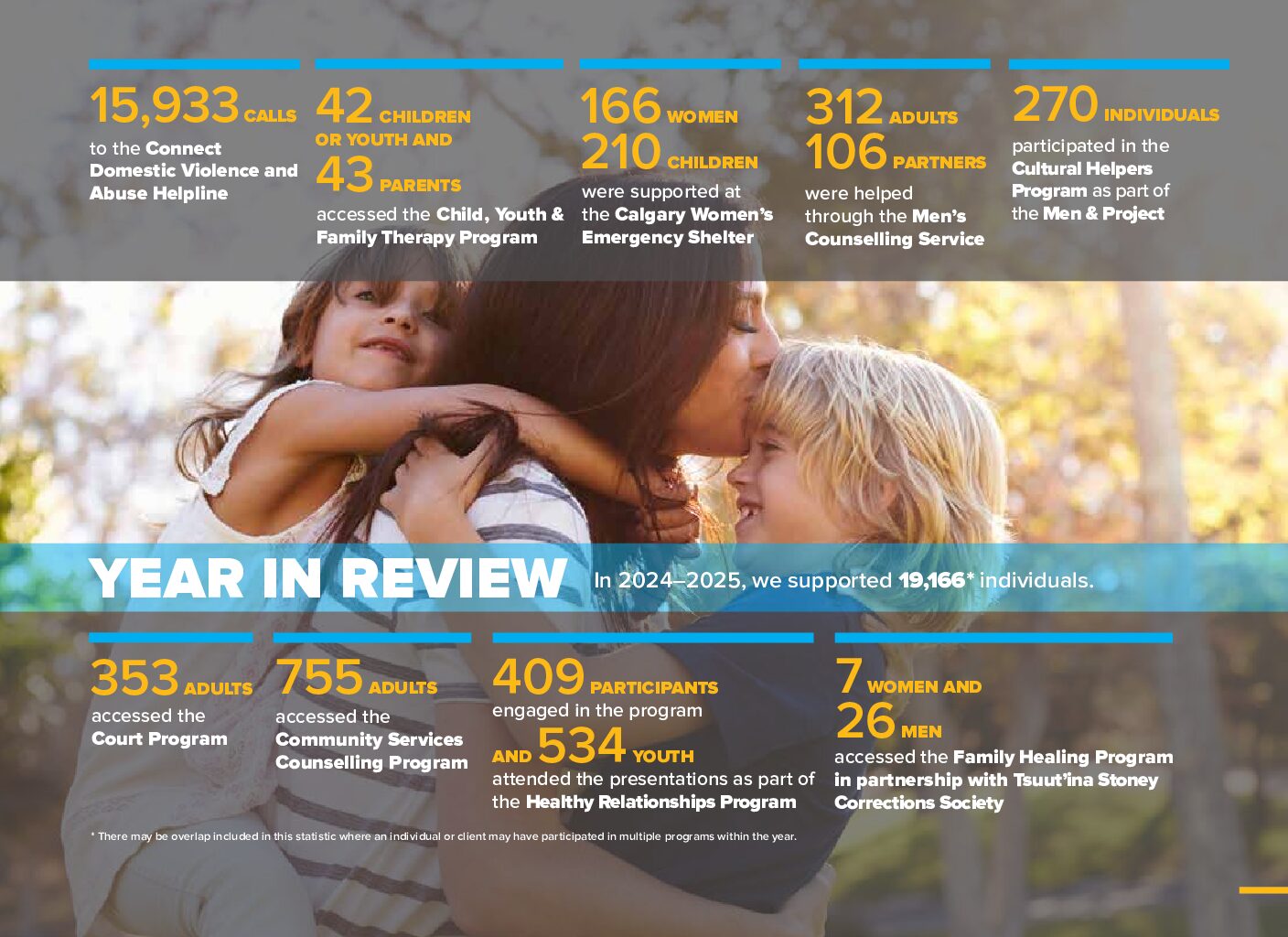Impact and Statistics

Click on these links for more information about our approach, programs and our accreditation.
General Statistics
It is important to note that many victims do not report their experiences to the police, resulting in underreported figures. It is estimated that 44% of women or 6.2 million women aged 15 and older have experienced some form of abuse in their intimate relationships (Government of Canada, 2022).
Approximately only one in five (19%) victims of spousal violence self-report their experiences to the police (Statistics Canada, 2022).
The police are notified of less than 30% of Intimate Partner Violence cases, and 44% of Canadian women report having been physically or sexually assaulted in an intimate relationship (Letourneau, Dawn, Barton, & Griggs, 2023).
Violence is more likely to occur against people who identify as women with disabilities, Indigenous women, women from visible minorities, or women who identify as LGBTQ+ (Government of Canada, 2022); Regardless of the type of intimate partner relationship, women constituted the majority (79%) of intimate partner violence victims (Statistics Canada, 2022).
Women and girls experienced family violence at more than twice the rate of men and boys (455 vs. 215), and intimate partner violence at over three times the rate (537 vs. 151) (Statistics Canada, 2023)
Calgary
59% of Calgarians are concerned about the rates of domestic violence. (Calgary Foundation, Quality of Life Report, 2024)
According to the Calgary Police Service, out of five homicides recorded in the 4th quarter of 2024, two were domestic-related.
In 2024, there were 18 homicides, with five being domestic-motivated. (Calgary Police Service, 2025) The number of domestic violence victims was 6% higher than the five-year average in the fourth quarter, and 14% above the average by the end of 2024. (Calgary Police Service, 2025)
In 2024, the Calgary Police Service responded to 4,351 incidents of domestic violence, up slightly from 4,289 incidents in 2023, an increase of just over 1%. (Calgary Police Service, 2025)
The number of domestic conflict calls declined by nearly 3%, with 18,687 calls in 2024 compared to 19,243 in 2023. (Calgary Police Service, 2025)
In the first quarter of 2025, domestic violence incidents increased by nearly 10% compared to the same period in 2024. (Calgary Police Service, 2025)
There was a 76% increase in Clare’s Law applications, rising from 17 in February 2024 to 30 in February 2025. This suggests heightened public awareness and proactive engagement in personal and community safety. (Calgary Police Service, 2025)
Alberta
As of 2023, Alberta reported a general rate of 385 victims per 100,000 population for intimate partner violence, which is slightly lower than in previous years. (Statistics Canada, 2023)
The rate of police-reported intimate partner violence against women in urban areas of Alberta is 535 incidents per 100,000 population. This is higher than the national average of 461 incidents per 100,000 population (Statistics Canada, 2022).
Canada
Approximately two out of three Canadians (60%) report experiencing physical and/or emotional abuse before the age of 15 (Raising Canada Report, 2024)
In Canada a women is killed by her intimate partner every 6 days. (Statistics Canada, 2019).
Family violence and abuse costs Canada an estimated $7.4 Billion every year. (This figure is derived from costs associated with health care, criminal justice, social services, and lost wages/productivity.) (Canadian Woman’s Foundation.)
Rates for police-reported family violence (+3%) and intimate violence (+1%) increased in 2023. (Statistics Canada, 2024)
There were 139,020 victims of family violence and 123,319 victims (Aged 12 years and older) of intimate partner violence that came to the attention of police, a rate of 350 victims of family violence and 354 victims of intimate partner violence per 100,000 population. (Statistics Canada, 2024)
From 2018 to 2023, rates of family violence (+17%) and intimate partner violence (+13%) rose. Increases were noted regardless of gender, although they were larger for men and boys (+19% for family violence and 20+ for intimate partner violence) than for women and girls (+15% for family violence and +12% for intimate partner violence).
In 2023, women and girls accounted for two-thirds (68%) of victims of family violence and nearly four in five victims of intimate partner violence (78%). (Statistics Canada, 2024)
The rate of family violence for women and girls (473 victims per 100,000 population) was twice as high as that for men and boys (220), while the rate of intimate partner violence was nearly four times higher for women and girls (549 victims per 100,000 population) than for men and boys (155). (Statistics Canada, 2024)
The rate of family violence against children and youth reached 362 victims per 100,000 population (296 for children aged 11 years and younger, and 485 for youth aged 12 to 17 years) in 2023, the highest rate since comparable data became available in 2009. The rate was nearly twice as high for girls (439) as it was for boys (259) in 2023. (Statistics Canada, 2024)
References
Statistics Canada, “Victims of police-reported family and intimate partner violence in Canada, 2021,” 2022.
Statistics Canada, “Trends in police-reported family violence,” Ottawa, 2023.
Statistics Canada, “Brief: Statistical profile of intimate partner violence in Canada,” Ottawa, 2022.
Calgary Police Service, “4th Quarter 2023 Statistical Report,” City of Calgary, Calgary, 2024.
City of Calgary, “Calgary police indicate increase in inquiries for domestic supports during Family Violence Prevention Month”, Calgary, 2023.
Government of Canada, “Fact sheet: Intimate partner violence,” Women and Gender Equality Canada, 2022.
N. Letourneau, . L. M. Dawn, S. S. Barton and K. Griggs, “Service Providers’ Perspectives: Reducing Intimate Partner Violence in Rural and Northern Regions of Canada,” The Canadian Journal of Nursing Research , vol. 55, no. 2, p. 165–175, 2023.